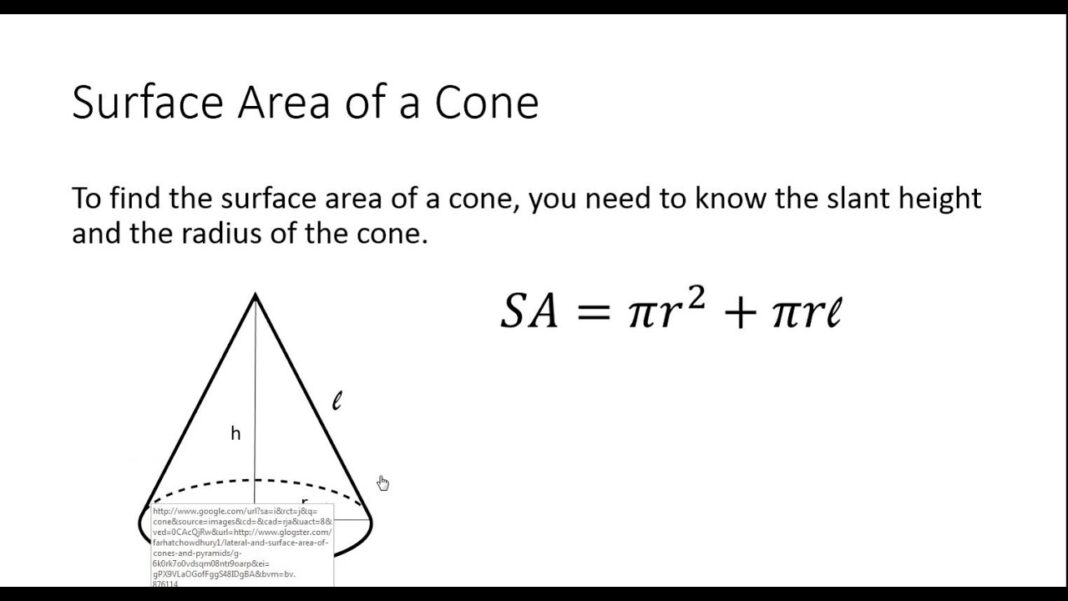Cone is a geometrical shape that is three-dimensional and is made up of a circular base. The surface area of the cone is the total region that the surface has occupied. The surface area of the cone is derived with the help of two formulas. The formula given for both is πr ( r + l ) and πrl respectively where ‘r’ is the radius of the cone and ‘l’ is the slant height of the cone.
What is the Volume of the Cone?
The volume of any geometric shape can be defined as the amount of space it can occupy within itself. Likewise, the volume of a cone can be defined as the total amount of cubic units it can fill within itself. A cone is made up of a circular base signifying that it is made up of radius and diameter. You must note one significant point that the resultant value is always written in the cubic units. The mathematical formula to find the volume of a cone is given as, ⅓ * π * r.r * h where r denotes the radius of the cone and l or h denotes the slant height of the cone. We shall solve some basic examples related to it in the coming sections.
Some Basic Examples Based on the Surface Area of a Cone
The surface area of the cone has been categorized into two types: the total surface area and the curved surface area. The formula given for both is πr ( r + l ) and πrl respectively where ‘r’ is the radius of the cone and ‘l’ is the slant height of the cone. Some examples related to it are listed below:
Example 1: Calculate the total surface area of the cone, if the radius and height of the cone are 5 cm and 3 cm respectively. Use the value of π as 22/7.
Solution: Given that,
Radius of the cone = 5 cm
Height ( slant ) of the cone = 3 cm
Using the formula for the total surface area = πr ( r + l ).
22/7 * 5 ( 5 + 3 ) = 22/7 * 5 * ( 8 )
22/7 * 5 * ( 8 ) = 22/7 * 40
22/7 * 40 = 125.6 cm unit square.
Hence, the total surface area of the cone for the given radius and height is equivalent to 125.6 cm unit square.
Example 2: Find the curved surface area of the cone, if the radius and height of the cone are 10 cm and 6 cm respectively. Use the value of π as 22/7.
Solution: Given that,
Radius of the cone = 10 cm
Height ( slant ) of the cone = 6 cm
Using the formula for the total surface area = πrl
22/7 * 10 * 6 = 22/7 * 60
22/7 * 60 = 188.4 cm unit square.
Hence, the curved surface area of the cone for the given radius and height is equivalent to 188.4 cm unit square.
Some Examples Related to the Volume of Cone
The mathematical formula to find the volume of a cone is given as, ⅓ * π * r.r * h where,
‘r’ is the radius of the cone and ‘l’ is the slant height of the cone. The examples related to it are mentioned below:
Example 1: Calculate the volume of the cone, if the radius and height are given as 6 cm and 8 cm respectively?
Solution: According to the question,
Radius of the cone = 6 cm
Height of the cone = 8 cm
Using the formula of the volume of cone = ⅓ * π * r.r * h .
⅓ * 3.14 * 6.6 * 8 = ⅓ * 3.14 * 36 * 8
⅓ * 3.14 * 36 * 8 = ⅓ * 3.14 * 288
⅓ * 3.14 * 288 = ⅓ * 904.3
⅓ * 904.3 = 271. 29 cm cubic units.
Therefore, the resultant value is = 271.29 cm cubic units.
If you want to learn about the volume and surface area of a cone in a detailed, fun, and interactive manner, visit Cuemath to book a free session now.








